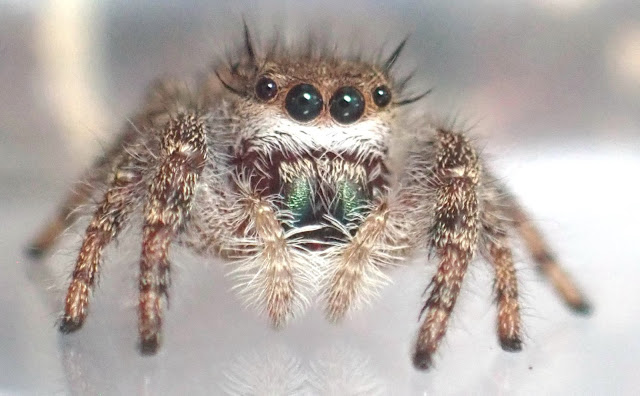I saw the little quarter inch cutie in the back of my truck with a pile of firewood. It moved carefully with a few tiny steps, typical of a jumping spider (JS, family Salticidae) which will reserve its leaps for dinner or defense. Although it was only a quarter inch long, I could make out the little hairs covering the body and legs. When challenged they may face the danger and back away in short spurts.
When a JS makes its jump it usually leaves a silk thread to dangle from if needed. When I bumped it with a stick it jumped and hung from the thread as I nudged it into a bug box. A few hours chilling in the refrigerator let me get a good facial photograph.
 JS can be recognized by their eye
pattern. All jumping spiders have four pairs of eyes, with the anterior
middle pair being particularly large. They have binocular vision that
allows them to measure the distance to their prey, necessary when they
pounce on a victim. The small pair on the top of their head seen above
gives them 360 degree vision to movement with a slight turn of the head.
JS can be recognized by their eye
pattern. All jumping spiders have four pairs of eyes, with the anterior
middle pair being particularly large. They have binocular vision that
allows them to measure the distance to their prey, necessary when they
pounce on a victim. The small pair on the top of their head seen above
gives them 360 degree vision to movement with a slight turn of the head.
You have to love the face of my jumping spider. Spiders have mouth parts called chelicerae and on JS species they are
often metallic blue-green. These function like fingers, the upper portion fixed and the lower flexible. They can contain glands for the toxic fluid to paralyze prey and manipulate their dinner.
There is a lot more to like about jumping spiders. For one thing, you can play with them, getting them to chase a laser light as shown in many Youtube videos. As described in this Atlantic article, their eyes are shaped like little telescopes, a tube with a lens at each end just like Galileo created. "Only three groups of animals have similar eyes: falcons, chameleons, and jumping spiders."
Bug Lady* describes the advantages of their hirsute body and legs:
"JS’s are relatively short-legged. Each leg ends with many tiny hairs, and each of those tiny hairs is further split into many more hairs, and each of those hairs is equipped with an “end foot.” With all those mini-feet, jumping spiders can boldly go where no spider has gone before—like straight up a pane of glass with the end feet gripping, just like a climbing wall, the “imperfections” in the glass."
There are an estimated 5,000 species of JS and mine doesn't have enough distinctive features to identify it further. The good news is that they can make the identification for mating. As in many other spider species, sex is dangerous as the female may decide that the first meeting is going to be a "dinner" date.
*Bug Lady's blog has a lot more interesting details of JS at this link.

